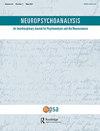Commentary on Mark Solms’ “New Project for a Scientific Psychology”
Q3 Psychology
引用次数: 5
Abstract
As we know from the introduction to Solms’ target article (2020), an editor of this journal articulated in a private communication to him the value of his revision of Freud’s Project (along with the fuller exposition offered in a forthcoming book), the value “for theoreticians, clinicians, and researchers” who seek “to account for the complex interactions between cognition and emotion; impulse and regulation; consciousness and unconscious processes; genetics and experience; etc.” The impact of this undertaking, however, has an even greater reach, extending much beyond the research lab or the consulting room to the broader domains of curiosity, the interrelation of how and why we know what we know, and the imaginary. Indeed, Solms’ New Project is Freud’s psychology revisioned as a natural science, but it is not for nothing that terms like “autopoiesis” and “intentionality,” to name but two, figure prominently not only in biology but in philosophy, both in phenomenology and aesthetics. And it is perhaps also not for nothing that it was by way of a lecturer in comparative literature, as he makes known in the introduction as well, that Solms first came upon Freud’s text. The point I would make is that “the articulation of an infrastructure of a truly neuropsychoanalytic model of the mind and brain,” to again cite Maggie Zellner, adds significantly to our understanding of, on the one hand, the need to know and modes of reflection, and, on the other, the origin of communication and modes of expression. Solms goes so far, in fact, as to ask in The Hidden Spring: A Journey to the Source of Consciousness, his soon-to-be-published book, “Where do observers come from?” And “How and why, in physical terms, does question-asking arise?,” an inquiry relevant not only to cognition, but to perceptual and affective activity as well, and to the capacity of the individual to imagine. Imagination is the means by which the writer, painter, and composer observe, the tool which allows their question-asking to occur. So, too, it is that of the reader, viewer, and listener. For what underlies that intentionalizing (à la Husserl) projection of the mind, its expressivity and resulting autopoietic construction of agency, is the seeking of knowledge, curiosity itself. What Solms makes eminently clear in the New Project is that the pursuit of knowledge emanates from a curiosity that takes an infinite number of forms. Drawing upon the achievements of Karl Friston and Jaak Panksepp as well as his own, he demonstrates with his modifications of Freud’s conceptualizations how homeostasis is served by the strategic design of the nervous system, a design at once economic (in its dynamic opposition to entropy), generative (in its “unfolding over a concentric predictive hierarchy”), and self-organizing (in its embeddedness within the psychophysiology of all life experience). Learning – which emerges from the feedback by sensory states of “the external consequences of prior active states” of the system and the consequent determination of subsequent states, all by way of the “homeostatic control centers that generate predicted consequences” – is intimately related to choice. “If an action does not yield the predicted sensory consequences,” Solms explains,马克·索姆斯《科学心理学的新项目》述评
正如我们从索尔姆斯的目标文章(2020)的引言中所知,该杂志的一位编辑在与他的私人交流中阐述了他对弗洛伊德计划的修订的价值(以及即将出版的一本书中提供的更全面的阐述),“对于理论家、临床医生和研究人员”的价值,他们寻求“解释认知和情绪、冲动和调节、意识和无意识过程、遗传学和经验等之间的复杂互动。”然而,这项工作的影响更大,远远超出了研究实验室或咨询室,延伸到更广泛的好奇心领域,我们如何以及为什么知道我们所知道的东西的相互关系,以及想象。事实上,索尔姆斯的《新计划》是弗洛伊德的心理学作为一门自然科学进行的修订,但“自我生成”和“意向性”等术语不仅在生物学中,而且在哲学中,在现象学和美学中都占有突出地位,这并非毫无意义。索尔姆斯第一次接触弗洛伊德的文本,也许也不是因为一位比较文学讲师,正如他在引言中所说的那样。我想说的是,再次引用Maggie Zellner的话,“一个真正的心理和大脑神经心理分析模型的基础设施的表达”,一方面大大增加了我们对知道的必要性和反思模式的理解,另一方面,也大大增加了沟通和表达模式的起源。事实上,索尔姆斯在他即将出版的书《隐藏的春天:意识之源之旅》中问道,“观察者来自哪里?”和“从物理角度来看,提问是如何产生的,为什么产生的?”这一问题不仅与认知有关,还与感知和情感活动以及个人的想象能力有关。想象是作家、画家和作曲家观察的手段,是他们提出问题的工具。读者、观众和听众也是如此。因为心灵的意向性(àla Hussell)投射、它的表现力和由此产生的能动性的自我生成结构的基础是对知识的追求和好奇心本身。索尔姆斯在《新计划》中明确指出,对知识的追求源于一种具有无限形式的好奇心。他借鉴了Karl Friston和Jaak Panksepp以及他自己的成就,通过对弗洛伊德概念的修改,展示了神经系统的战略设计是如何服务于稳态的,这是一种经济的(与熵的动态对立)、生成的(在“同心预测层次上展开”)、,以及自组织(嵌入所有生命体验的心理生理学中)。学习——来自系统“先前活动状态的外部后果”的感觉状态的反馈,以及随后对后续状态的确定,所有这些都是通过“产生预测后果的稳态控制中心”产生的——与选择密切相关。索尔姆斯解释道:“如果一个动作没有产生预期的感官后果。”,
本文章由计算机程序翻译,如有差异,请以英文原文为准。
求助全文
约1分钟内获得全文
求助全文
来源期刊

Neuropsychoanalysis
Psychology-Neuropsychology and Physiological Psychology
CiteScore
2.50
自引率
0.00%
发文量
24
 求助内容:
求助内容: 应助结果提醒方式:
应助结果提醒方式:


